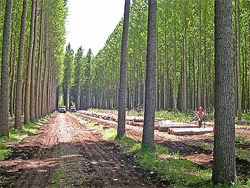Within five to seven years fast growing trees and grasses might become economically viable alternatives to corn as a source of renewable fuel ethanol, reducing the need for pollutants that now cause a massive "dead zone" in the Gulf of Mexico.
"Ethanol from cellulose, whether from trees or other sources, will be the way to go in the very near future," says Dr. Gopi Podila, a University of Alabama in Huntsville (UAHuntsville) biologist who has been conducting research on high-yield trees for more than a decade. "Trees are cheaper to raise than corn, have a competitive yield and they don’t need as much of the fertilizers that are causing all of the problems in the Gulf.
"These trees also offer the U.S. a realistic option for producing enough renewable energy to make a meaningful dent in fossil fuel imports."
Due to the rising demand for ethanol, farmers in the U.S. planted more corn this year than in any year since World War II. The corn crop is fertilized with millions of pounds of nitrogen-based fertilizer. An estimated 210 million pounds of those nitrates are not absorbed by the corn, run off into streams and rivers, and are carried to the Gulf of Mexico each year, where it causes a massive "bloom" of algae.
When the algae dies it sinks to the bottom, where it absorbs oxygen as it decays. In recent years that oxygen depletion has created an aquatic "dead zone" covering about 8,000 square miles in which shrimp, fish, oysters and crabs cannot survive.
Growing high-yield trees might have several economic and environmental advantages over corn, said Podila, who chairs UAH's Biological Sciences Department. "For one thing, there are some trees like poplar and aspen, where you could get a harvest every five or six years but you would only have to plant once every 30 to 40 years because they grow back from the roots. That is a significant cost savings, if only for the fuel used for planting and harvesting every year.
"Many of these trees and grasses like switchgrass will grow on land that might have marginal value for farming. Maybe it is too steep for planting or too dry for farming, but that wouldn't be as much of a problem for trees. You could have an extra crop growing on land that isn't presently productive. There are vast areas of marginal land in the U.S. that could be used for this purpose without having an impact on other crops."
Because they absorb tons of carbon dioxide from the air, trees are also one of the most efficient tools available for combating rising levels of carbon dioxide in the atmosphere and manmade global warming. Burning fuel ethanol made from trees recycles CO2 that was recently taken out of the atmosphere.

